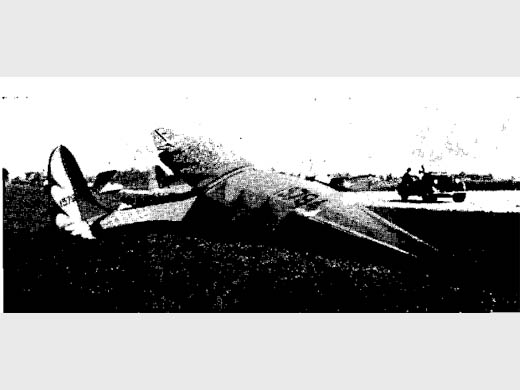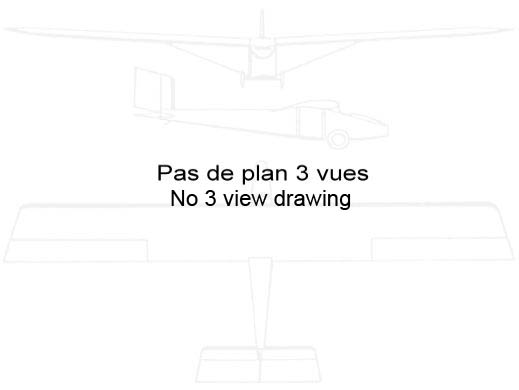
Auburn Sun Spot
| DONNÉES GÉNÉRALES |
| Année du premier vol (ou de design, si seul projet) |
1936 |
| Pays | USA |
| Designer(s) | AUBURN, Robert J. |
| Premier constructeur | AUBURN, Robert J. |
| Type d'appareil | Planeur |
| Fonction | Entraînement |
| SPÉCIFICATIONS TECHNIQUES |
| Envergure | 14 m |
| Longueur | 5.63 m |
| Hauteur | -- |
| Allongement | 11.5 |
| Surface alaire | 16.7 m2 |
| Profil aile | -- |
| Masse à vide | 150 kg |
| Masse maxi | 250 kg |
| Charge alaire | -- |
| Vitesse mini | 45 km/h |
| Vitesse maxi | -- |
| Finesse maxi | |
| Taux de chute mini | -- |
| Nb sièges | 1 |
| Structure | -- |
AUTRES INFORMATIONS
| Constructeur(s) |
| ||||||
| Infos techniques | Approx. vitesse de vol 65 km/h | ||||||
| Histoire résumée | The "Sun Spot" is a glider of the high performance utility type, The design embodies certain features that give it an individuality seldom found in utility gliders, The ship was designed and constructed with these objects in view, First, it should have soaring performance above the usual utility glider, Secondly, it should be rugged, and not easily damaged by rough handling. Thirdly, three men should be able to assemble or dismantle the ship "within a time comparable with utility gliders. Construction of the glider is quite conventionaL The fuselage is built of welded chrome-moly steel tubing, fabric covered, The wings are made of spruce ribs and spruce (built-up "1"section) spars, with double wire drag bracing and fabric covering. The control system is unique in that ball bearings are used for control surface hinges and for important bearing points throughout the system, The common "Joy" control stick is replaced by a torque tube control which projects from a universal behind the seat to a comfortable position beneath the pilot's arm. A small adjustable hand grip is mounted on the end of the torque tube. This control arrangement was originally conceived and used by R. E. Franklin several years ago. It allows the pilot to relax during long flights, as the hand grip can be shifted to fit any reclining position the pilot may wish to take. A glider is of little value without adequate provision for carrying and storing both the ship parts and the necessary additional equipment, Consequently, a great deal of thought was given to the construction of the trailer, It is built entirely of welded steel tubing and is canvas covered so as to be completely enclosed. The glider parts are taken in through the forward opening. Wings and fuselage are held by steel fixtures which ride on a system of tracks fastened to the upper structure of the framework. The procedure in stowing a part is merely to hook the fixture on the correct track, push the part in, and then lock it in place with bolt and safety pin. Actual construction of the glider and trailer consumed slightly more than eighteen months time to complete. A certain amount of the labor was purchased, but for the most part of no expense. A great deal of the work was done at the University of Michigan in connection with the U. of M. Glider Club. Reasonably accurate records of labor time needed to build both glider and trailer show a total of over 3000 man-hours. Of this total, approximately 1100 hours were required for the wings alone, 900 hours for the fuselage, and about 1000 hours for construction of the trailer and supplementary equipment. Construction costs were as follows: Glider materials, $450; trailer materials, $215; paid labor, $100; instruments, $80; parachute, $75; total, $920. All materials used were of the highest grade. The "Sun Spot" was flown in competition for the first time at the Seventh Annual Soaring Contest. It performed splendidly, in spite of the fact that it was flown by an inexperienced pilot. | ||||||
| Liens personnalités | Pas de personnalité associée. | ||||||
| Compléments docs |
SOURCES DOCUMENTAIRES
| Liens WEB | Pas de site référencé. |
| Livres | Pas de livre référencé. |
| Autres sources | Building the Sun Spot, Robert J. Auburn, Soaring, vol 1 n°6, juin 1937, pages 6-8. Texte + 2 photos + specs. Soaring, vol 2 n°8, août 1938, page 7. Photo : Bob Auburn devant son Sun Spot. |

Team J2mcL © 2003 -
- Pages optimisées pour Mozilla Firefox

